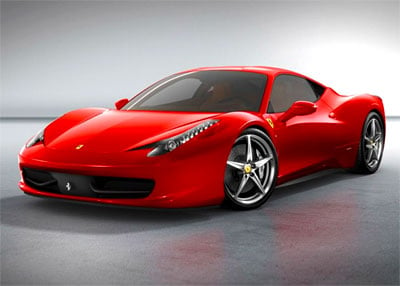Just a few days after its star driver Felipe Massa was rushed to hospital with career-threatening head and eye injuries, Ferrari has turned back to its core business, releasing details of its newest model, the 458 Italia, a car that it claims represents one of the largest leaps forward in technology, performance and emissions ever seen out of Maranello.
Never mind that the top end of the luxury car business has been reduced to walking pace, Ferrari is bravely stirring the market with its new rear-engined rocket, capable of a zero-100km/h time of 3.4secs and a top speed of 325km/h.
That’s nearly 100km/h more than a Ferrari California reached recently in the hands of a motoring journalist on a Western Australian country road.The neat and compact Ferrari 458 Italia, the replacement for the 430, is a completely new car from every point of view – engine, design, aerodynamics, handling, instrumentation and ergonomics.With the 458 Italia, Ferrari now offers two eight-cylinder models that share a common, competition-derived DNA.Both it and the California are sporty , though sporty and fun to drive, are aimed at two very different kinds of buyer. The California was created for owners requiring a more versatile sports car with a practical edge, while the 458 Italia is designed for owners for whom the priority is uncompromising on-road performance with occasional track day capability (but still with a side to its character that allows for reasonably functional day to day driving). Gee, this is sounding more and more like a Porsche 911GT3….Like most recent Ferrari production models, the two-seater leans heavily on the Scuderia’s Formula One experience and technology.The 458 Italia features an different driving environment with a new kind of steering wheel and dashboard that is the direct result of track activities. Once again input from Michael Schumacher – who was involved from the very start of the 458 Italia project – played a role.The Ferrari 458 Italia’s Pininfarina styling has been very heavily influenced by the requirements for aerodynamic efficiency, as can be seen from the downforce reading of of 140 kg at 200 km/h.The front features a single opening for the front grille and side air intakes, with aerodynamic sections and profiles designed to direct air to the coolant radiators and the new flat underbody. The nose also sports small aeroelastic winglets which generate downforce and, as speed rises, deform to reduce the section of the radiator inlets and cut drag.The new 4499 cc V8 is the first Ferrari direct injection engine to be mid-rear mounted. It has a very low piston compression height typical of racing engines which contributed to achieving its compression ratio of 12.5:1. Equipped with the traditional flat-plane crankshaft, the engine delivers 425 kW at 9000 rpm.Its outstanding power output of 94 kW/litre sets a new benchmark not only for the whole Ferrari range but, the company insists, also for the entire market segment.Maximum torque is 540 Nm at 6000 rpm, over 80 per cent of which is available from 3250 rpm. Specific torque is a handy 120 Nm/litre.The car’s aurals are also typical Ferrari, with an powerful growl emerging from the engine before it channels through to the exhaust’s three rear tailpipes.The 458 Italia is equipped with the seven-speed dual-clutch transmission is a boost to both performance and economy (not that owners really give a fig about the latter).This new Ferrari is also a major leap forward when it comes to cutting emissions. Despite the fact that the new engine is significantly more powerful than the V8s that preceded it, the Ferrari 458 Italia produces just 320 g/km of CO2 and fuel consumption is 13.7 l/100 km (combined cycle)..Fuel efficiency and performance are also behind the weight reduction priority during the design phase. The 458 Italia has a dry weight of 1380 kg with a power-to-weight ratio of 2.42 kg/CV. Weight distribution is skewed to the engine’s rearward engine location – with 58 per cent over the rear axle and 42 over the front half.The aluminium chassis, is a technical tour de force and incorporates various types of advanced alloys along with aerospace industry-derived manufacturing and bonding techniques.Suspension features twin wishbones at the front and a multi-link set-up at the rear.There has been further integration of the E-Diff and F1-Trac (now controlled by the same ECU) and their respective mappings, resulting in a 32 per cent increase in longitudinal acceleration out of corners compared to previous models. The evolution of the control logic, with even faster and more accurate calculation of levels of grip, gives the promise of slicker roadholding, better handling and ease of control on the limit.The same ECU also governs the high-performance ABS, providing even more precise control over the logic threshold and greater efficiency. The brakes also feature a prefill function whereby the pistons in the callipers move the pads into contact with the discs on lift off to minimise delay in the brakes being applied. This combined with the ABS has cut the 100-0 km/h braking distance to a mere 32.5 metres.Deliveries of the Ferrari 458 Italia to Australia and New Zealand will start in mid-2010, with orders already being taken by the Australian and New Zealand importer. Local prices and specifications will be announced when deliveries start.
Ferrari 458 Italia – Technical specifications
Dimensions
Length 4527 mm Width 1937 mm Height 1213 mm Wheelbase 2650 mm Dry weight 1380 kg * Weight/power ratio 2,42 kg/CV (7.16 lbs/kW) Weight distribution fr/r 42%/58%
Engine
Type V8 – 90° Displacement 4499 cc Maximum power 425 kW @ 9000 rpm Maximum torque 540 Nm @ 6000 rpm Compression ratio 12.5:1
Tyres
Front 235/35 ZR20 8.5″ Rear 295/35 ZR20 10.5″
Performance
Maximum speed 325 km/h 0-100 km/h 3.4 s
Fuel consumption + emissions
Fuel consumption*** 13.7 l/100 km Emissions*** 320 g CO2/km
Gearbox
Dual-clutch, 7-speed F1
Electronics
E-Diff3, F1-Trac, high-performance ABS
* With forged wheels and Racing seats *** Combined cycle (ECE+EUDC)





